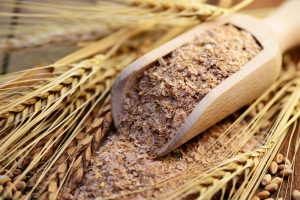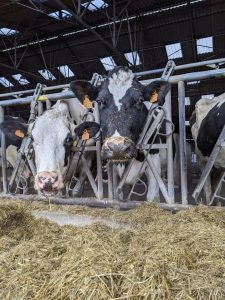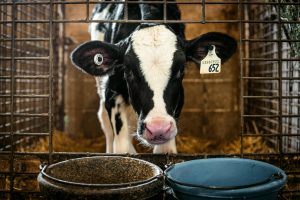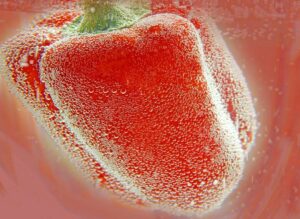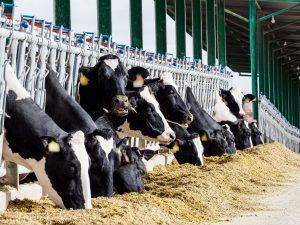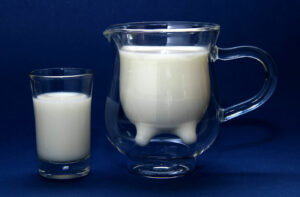Fernando Diaz
Concentrate intake is a very important factor in the nursing phase of young heifers. Starter grain supplies not only essential nutrients for growth, but also stimulates the development of the rumen and ruminal papillae. A paper published by researchers from Virginia Polytechnic Institute and State University highlights the importance of concentrate in the pre-weaning phase.
Solid feed increases rumen development
The authors (Yohe et al., 2010) assessed the effects of two types of feeding strategies on the growth and development of rumen epithelium of Holstein calves during the first 6 weeks of life. One diet was based exclusively on liquid feeding with milk replacer (22.0% protein and 21.5% fat dry matter basis), the other combined the same replacer with a texturized starter ration (21.5% protein).
Both diets supplied the same energy (4.0 Mcals of metabolizable energy per day) and protein (0.17 kg of digestible protein per day); to maintain them isocaloric and isonitrogenous, the researchers adjusted the diet with concentrate weekly, reducing the contribution of the replacer. The calves in the liquid feeding group received a constant amount of milk replacer throughout the experiment (0.85 kg/day), while calves with access to feed received decreasing amounts of dairy replacer (0.84, 0.83, 0.76, 0.72 and 0.54 kg/day at weeks 1, 2, 3, 4 and 5 of the experiment, respectively) as they increased their consumption of starter feed (0.016, 0.027, 0.137, 0.267, and 0.437 kg/day) throughout the experiment.
Body weight and average daily gain (0.5 kg/day) were similar for both groups. However large differences in morphology and rumen development were observed when calves were slaughtered at 6 weeks of age. The weight of the rumen and reticulum was much higher in calves receiving concentrate (0.68 kg) compared to those fed only dairy replacement (0.39 kg).
In addition, the surface of the rumen papillae observed in the biopsies was 5 times greater in calves with access to dry feed (0.76 vs. 0.15 mm2). These results show that solid feed increases the development of the rumen through the proliferation of ruminal tissue and elongation of rumen papillae.
Relationship between starter intake and the ingestion of milk
One of the most important factors affecting starter intake is the ingestion of milk or milk replacer. Milk consumption significantly affects concentrate intake since it is very limited by the small size of the rumen. According to a meta-analysis published in the Journal of Dairy Science evaluating 9 studies (Gelsinger et al., 2016), a 100 g increase in liquid food consumption causes a linear reduction in intake of 66 g of solid food.
Another more recent study found that this relationship between milk and concentrate consumption depends on the age of the calf, so that 100 g of liquids decreases intake of concentrate by 13 g of solids in 1-month old calves, and 93 g in 2-months calves (Silva et al., 2019).
A study conducted by researchers at Pennsylvania State University reported that for every 100 g/day increase in starter intake before weaning, first-lactation cows produced 127.0 kg more milk, 8.4 kg more milk fat and 4.0 kg of milk protein. This shows that concentrate intake during preweaning not only influences animal growth but also its future milk production.
Feed additives to increase intake
Different feed additives are available in the market that can be added to the ration or calf milk to enhance solids’ intake.
Flavorings
Flavorings are additives used in the animal food industry to improve the taste and smell of food. The sense of taste is very well developed in dairy cattle, which can recognize the five basic flavors: sweet, salty, bitter, sour and umami (flavor of glutamates). Therefore, the inclusion of favorite flavors in the starter feed could help stimulate and increase intake. Different flavors such as vanilla, dairy, spicy, fenugreek, aniseed and fruity are nowadays available in the market.
Minerals: Organic Zinc
Zinc is an essential mineral to maintain the adequate functioning of the intestinal barrier and the regeneration of its epithelium. A recent study evaluated the effects of feeding dairy calves a Zn chelate (Zn-glycine) on growth and feed intake. The experiment included 72 Holstein calves from days 3 to 80 of life. Treatments were:
- Zn Supplement-Free Control (CON)
- 100 mg/day of Zn chelate in milk (days 3 to 65; Zn3)
- 100 mg/day of Zn chelate in milk (days 50 to 65; Zn50)
The researchers (Adab et al., 2020) observed no effects on feed intake during the first month of the experiment (average: 798 g/day). During the second month however, calves that received Zn showed higher dry matter intakes (1,642 g/d) compared with those that did not receive the mineral (1,521 g/d).
Vitamins: Folic acid
Folic acid is a vitamin from the B complex that mediates the transfer of one carbon units; its involved in the synthesis of nucleic acids (DNA) and amino acids (methionine). The name folic acid comes from folium (“leaf”, in Latin), since this vitamin was originally isolated from spinach leaves. In ruminant animals, rumen microorganisms produce enough folic acid to prevent the deficiency of this vitamin.
However, in pre-weaned calves the rumen is not fully developed, and the production of folic acid by the ruminal microflora is thus very limited, as a result folic acid supplementation improves their intake and growth during the first months of life.
Application
An article previously published in the DKC Quarterly (How much milk should we feed our calves?) explains that a breeding program that combines a moderate supply of milk (6 – 7 liters/day) together with a good quality texturized starter feed ensures adequate calf growth, so the supply of higher milk quantities can affect rumen development and growth of calves post-weaning.
About the author
Fernando Diaz is the Dairy Knowledge Center’s Director. Dr. Diaz works as an independent Dairy Nutrition and Management Consultant. He provides consultation to dairies and feed companies including nutrition and feeding management, forage and crop plans, and research and product development of new feedstuffs, additives, and technologies for dairy cows. Fernando lives in Brookings, South Dakota and can be reached at fernando@dairykc.com.
© 2020 Dairy Knowledge Center. All Rights Reserved.



